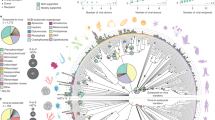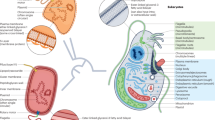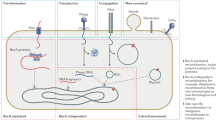Abstract
Horizontal gene transfer—the exchange of genes across mating barriers—is recognized as a major force in bacterial evolution1,2. However, in eukaryotes it is prevalent only in certain phagotrophic protists and limited largely to the ancient acquisition of bacterial genes3,4,5. Although the human genome was initially reported6 to contain over 100 genes acquired during vertebrate evolution from bacteria, this claim was immediately and repeatedly rebutted7,8. Moreover, horizontal transfer is unknown within the evolution of animals, plants and fungi except in the special context of mobile genetic elements9,10,11,12. Here we show, however, that standard mitochondrial genes, encoding ribosomal and respiratory proteins, are subject to evolutionarily frequent horizontal transfer between distantly related flowering plants. These transfers have created a variety of genomic outcomes, including gene duplication, recapture of genes lost through transfer to the nucleus, and chimaeric, half-monocot, half-dicot genes. These results imply the existence of mechanisms for the delivery of DNA between unrelated plants, indicate that horizontal transfer is also a force in plant nuclear genomes, and are discussed in the contexts of plant molecular phylogeny and genetically modified plants.
This is a preview of subscription content, access via your institution
Access options
Subscribe to this journal
Receive 51 print issues and online access
$199.00 per year
only $3.90 per issue
Buy this article
- Purchase on Springer Link
- Instant access to full article PDF
Prices may be subject to local taxes which are calculated during checkout




Similar content being viewed by others
References
Ochman, H., Lawrence, J. G. & Groisman, E. A. Lateral gene transfer and the nature of bacterial innovation. Nature 405, 299–304 (2000)
Koonin, E. V., Makarova, K. S. & Aravind, L. Horizontal gene transfer in prokaryotes: quantification and classification. Annu. Rev. Microbiol. 55, 709–742 (2001)
Nixon, J. E. et al. Evidence for lateral transfer of genes encoding ferredoxins, nitro-reductases, NADH oxidase, and alcohol dehydrogenase 3 from anaerobic prokaryotes to Giardia lamblia and Entamoeba histolytica. Eukaryotic Cell 1, 181–190 (2002)
Andersson, J. O., Sjögren, Å. M., Davis, L. A. M., Embley, T. M. & Roger, A. J. Phylogenetic analyses of diplomonad genes reveal frequent lateral gene transfers affecting eukaryotes. Curr. Biol. 13, 94–104 (2003)
Archibald, J. M., Rogers, M. B., Toop, M., Ishida, K.-I. & Keeling, P. J. Lateral gene transfer and the evolution of plastid-targeted proteins in the secondary plastid-containing alga, Bigelowiella natans. Proc. Natl Acad. Sci. USA 100, 7678–7683 (2003)
Lander, E. S. et al. Initial sequencing and analysis of the human genome. Nature 409, 860–921 (2001)
Stanhope, M. J. et al. Phylogenetic analyses do not support horizontal gene transfers from bacteria to vertebrates. Nature 411, 940–944 (2001)
Salzberg, S. L., White, O., Peterson, J. & Eisen, J. A. Microbial genes in the human genome: lateral transfer or gene loss? Science 292, 1903–1906 (2001)
Robertson, H. M. in Mobile DNA II (eds Craig, N. L., Craigie, R., Gellert, M. & Lambowitz, A. M.) 1093–1110 (ASM, Washington DC, 2002)
Eickbush, T. H. & Malik, H. S. in Mobile DNA II (eds Craig, N. L., Craigie, R., Gellert, M. & Lambowitz, A. M.) 1111–1144 (ASM, Washington DC, 2002)
Goddard, M. R. & Burt, A. Recurrent invasion and extinction of a selfish gene. Proc. Natl Acad. Sci. USA 96, 13880–13885 (1999)
Cho, Y., Qiu, Y.-L., Kuhlman, P. & Palmer, J. D. Explosive invasion of plant mitochondria by a group I intron. Proc. Natl Acad. Sci. USA 95, 14244–14249 (1998)
Adams, K. L., Qiu, Y. L., Stoutemyer, M. & Palmer, J. D. Punctuated evolution of mitochondrial gene content: High and variable rates of mitochondrial gene loss and transfer to the nucleus during angiosperm evolution. Proc. Natl Acad. Sci. USA 99, 9905–9912 (2002)
Wolfe, K. H., Li, W. S. & Sharp, P. M. Rates of nucleotide substitution vary greatly among plant mitochondrial, chloroplast, and nuclear DNAs. Proc. Natl Acad. Sci. USA 84, 9054–9058 (1987)
Laroche, J., Li, P., Maggia, L. & Bousquet, J. Molecular evolution of angiosperm mitochondrial introns and exons. Proc. Natl Acad. Sci. USA 94, 5722–5727 (1997)
Adams, K. L., Daley, D. O., Qiu, Y. L., Whelan, J. & Palmer, J. D. Repeated, recent and diverse transfers of a mitochondrial gene to the nucleus in flowering plants. Nature 408, 354–357 (2000)
Maynard Smith, J. Analyzing the mosaic structure of genes. J. Mol. Evol. 34, 126–129 (1992)
Qiu, Y. L. et al. The earliest angiosperms: evidence from mitochondrial, plastid and nuclear genomes. Nature 402, 404–407 (1999)
Barkman, T. J. et al. Independent and combined analyses of sequences from all three genomic compartments converge on the root of flowering plant phylogeny. Proc. Natl Acad. Sci. USA 97, 13166–13171 (2000)
Adams, K. L. et al. Intracellular gene transfer in action: Dual transcription and multiple silencings of nuclear and mitochondrial cox2 genes in legumes. Proc. Natl Acad. Sci. USA 96, 13863–13868 (1999)
Wikstrom, N., Savolainen, V. & Chase, M. W. Evolution of the angiosperms: Calibrating the family tree. Proc. R. Soc. Lond. B 268, 2211–2220 (2001)
Feschotte, C. & Wessler, S. R. Mariner-like transposases are widespread and diverse in flowering plants. Proc. Natl Acad. Sci. USA 99, 280–285 (2002)
Intrieri, M. C. & Buiatti, M. The horizontal transfer of Agrobacterium rhizogenes genes and the evolution of the genus Nicotiana. Mol. Phylogenet. Evol. 20, 100–110 (2001)
Blanchard, J. L. & Schmidt, G. W. Pervasive migration of organellar DNA to the nucleus in plants. J. Mol. Evol. 41, 397–406 (1995)
Stupar, R. M. et al. Complex mtDNA constitutes an approximate 620-kb insertion on Arabidopsis thaliana chromosome 2: Implication of potential sequencing errors caused by large-unit repeats. Proc. Natl Acad. Sci. USA 98, 5099–5103 (2001)
Zardoya, R., Ding, X. D., Kitagawa, Y. & Chrispeels, M. J. Origin of plant glycerol transporters by horizontal gene transfer and functional recruitment. Proc. Natl Acad. Sci. USA 99, 14893–14896 (2002)
Swofford, D. L. PAUP*: Phylogenetic analysis using parsimony (*and other methods) Version 4 (Sinauer, Sunderland, Massachusetts, 1998).
Hulsenbeck, J. P. & Ronquist, F. MrBayes: Bayesian inference of phylogenetic trees. Bioinformatics 17, 754–755 (2001)
Shimodaira, H. & Hasegawa, M. Multiple comparisons of log-likelihoods with applications to phylogenetic inference. Mol. Biol. Evol. 16, 1114–1116 (1999)
Kadowaki, K., Kubo, N., Ozawa, K. & Hirai, A. Targeting presequence acquisition after mitochondrial gene transfer to the nucleus occurs by duplication of existing targeting signals. EMBO J. 15, 6652–6666 (1996)
Acknowledgements
We thank C. Mathews for technical assistance; E. Knox for creating Fig. 4, for drafting Fig. 1 and for discussion; L. Goertzen, E. Knox, R. Olmstead, D. Rice and S. Stefanovic for critical reading of the manuscript; R. Gardner for providing several Actinidia DNAs; M. Stoutemyer and J. Gastony for help in obtaining plant material; and B. Hall and the University of California Santa Cruz arboretum for supplying leaf material for Amborella. Financial support was provided by the US NIH.
Author information
Authors and Affiliations
Corresponding author
Ethics declarations
Competing interests
The authors declare that they have no competing financial interests.
Supplementary information
41586_2003_BFnature01743_MOESM1_ESM.pdf
Supplementary Figure 1: Phylogenetic trees of rps2 and rps11 that show much greater divergence of nuclear than mitochondrial genes in plants. (PDF 192 kb)
41586_2003_BFnature01743_MOESM3_ESM.pdf
Supplementary Figure 3: Nucleotide alignment used for the rps11 analysis shown in Fig. 2b, 2d and 2e of the main text. (PDF 134 kb)
41586_2003_BFnature01743_MOESM5_ESM.pdf
Supplementary Figure 5: Nucleotide alignment used for the rps11 upstream sequence analysis shown in Fig. 2c of the main text. (PDF 36 kb)
41586_2003_BFnature01743_MOESM8_ESM.doc
Supplementary Information: 1) Ruling out DNA contamination or mix-up, 2) Mitochondrial provenance of horizontally-acquired plant genes, 3) The tip of an iceberg of mitochondrial HGT in plants, 4) Parametric bootstrapping 5) Supplemental references. (DOC 50 kb)
Rights and permissions
About this article
Cite this article
Bergthorsson, U., Adams, K., Thomason, B. et al. Widespread horizontal transfer of mitochondrial genes in flowering plants. Nature 424, 197–201 (2003). https://doi.org/10.1038/nature01743
Received:
Accepted:
Issue Date:
DOI: https://doi.org/10.1038/nature01743
This article is cited by
-
Comparative analysis of chloroplast and mitochondrial genomes of sweet potato provides evidence of gene transfer
Scientific Reports (2024)
-
Remarkable mitochondrial genome heterogeneity in Meniocus linifolius (Brassicaceae)
Plant Cell Reports (2024)
-
Regardless of having identical photosynthetic pathways, chloroplast genomes vary depending on whether the host plant is monocotyledonous or dicotyledonous
Genetic Resources and Crop Evolution (2024)
-
Assembly and comparative analysis of the complete mitochondrial genome of Ilex metabaptista (Aquifoliaceae), a Chinese endemic species with a narrow distribution
BMC Plant Biology (2023)
-
Investigation of B-atp6-orfH79 distributing in Chinese populations of Oryza rufipogon and analysis of its chimeric structure
BMC Plant Biology (2023)
Comments
By submitting a comment you agree to abide by our Terms and Community Guidelines. If you find something abusive or that does not comply with our terms or guidelines please flag it as inappropriate.



